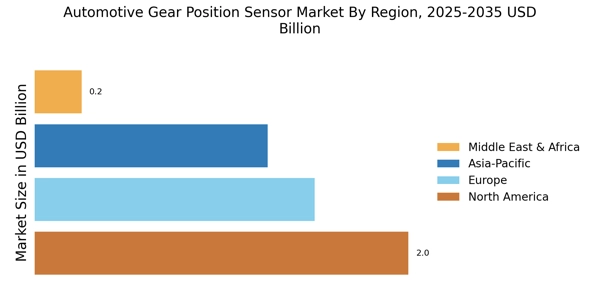Shift Towards Electrification of Vehicles
The transition towards electrification in the automotive sector is another significant driver influencing the Automotive Gear Position Sensor Market. As electric vehicles (EVs) gain traction, the need for efficient and reliable gear position sensors becomes increasingly critical. EVs often utilize advanced transmission systems that require precise gear position feedback to optimize performance and energy efficiency. Market analysis indicates that the EV segment is expected to witness substantial growth, with projections estimating that electric vehicles could account for a significant portion of total vehicle sales by 2030. This shift necessitates the integration of high-quality gear position sensors, which are essential for the effective operation of electric drivetrains. Thus, the electrification trend is likely to stimulate demand within the Automotive Gear Position Sensor Market.
Technological Advancements in Sensor Technologies
Technological advancements in sensor technologies are significantly influencing the Automotive Gear Position Sensor Market. Innovations such as the development of more accurate, reliable, and compact sensors are enhancing the performance of gear position sensing systems. The introduction of technologies like magnetoresistive and capacitive sensors has improved the precision and durability of gear position sensors, making them more appealing to automotive manufacturers. Market data suggests that the sensor technology segment is experiencing rapid growth, with advancements leading to increased adoption rates in various vehicle types. As manufacturers seek to enhance vehicle performance and reliability, the demand for advanced gear position sensors is likely to rise, further propelling the Automotive Gear Position Sensor Market.
Growing Consumer Preference for Connected Vehicles
The growing consumer preference for connected vehicles is emerging as a key driver for the Automotive Gear Position Sensor Market. As consumers increasingly seek vehicles equipped with connectivity features, the demand for sensors that can provide real-time data on gear positions is rising. Connected vehicles rely on a network of sensors to communicate with various systems, enhancing the overall driving experience. Market Research Future indicates that the connected vehicle segment is expected to grow significantly, with projections suggesting that a substantial percentage of new vehicles will be equipped with connectivity features by 2027. This trend necessitates the integration of advanced gear position sensors, which are essential for the seamless operation of connected vehicle technologies. Consequently, the Automotive Gear Position Sensor Market is likely to benefit from this growing consumer demand.
Rising Demand for Advanced Driver Assistance Systems
The increasing adoption of Advanced Driver Assistance Systems (ADAS) is a pivotal driver for the Automotive Gear Position Sensor Market. As vehicles become more sophisticated, the need for precise gear position sensing has escalated. ADAS technologies, which enhance vehicle safety and driving comfort, rely heavily on accurate sensor data. According to industry reports, the market for ADAS is projected to grow significantly, with estimates suggesting a compound annual growth rate of over 10% in the coming years. This growth directly correlates with the demand for automotive gear position sensors, as they play a crucial role in ensuring the reliability and functionality of these systems. Consequently, manufacturers are likely to invest in innovative sensor technologies to meet this rising demand, thereby propelling the Automotive Gear Position Sensor Market forward.
Regulatory Push for Enhanced Vehicle Safety Standards
Regulatory frameworks aimed at enhancing vehicle safety standards are driving the Automotive Gear Position Sensor Market. Governments worldwide are increasingly implementing stringent safety regulations that mandate the incorporation of advanced safety features in vehicles. These regulations often require the use of precise gear position sensors to ensure that safety systems function correctly. For instance, the implementation of regulations such as the Euro NCAP protocols has led to a heightened focus on vehicle safety technologies. As a result, automotive manufacturers are compelled to integrate high-performance gear position sensors into their vehicles to comply with these regulations. This regulatory push is expected to create a robust demand for automotive gear position sensors, thereby positively impacting the Automotive Gear Position Sensor Market.


















Leave a Comment